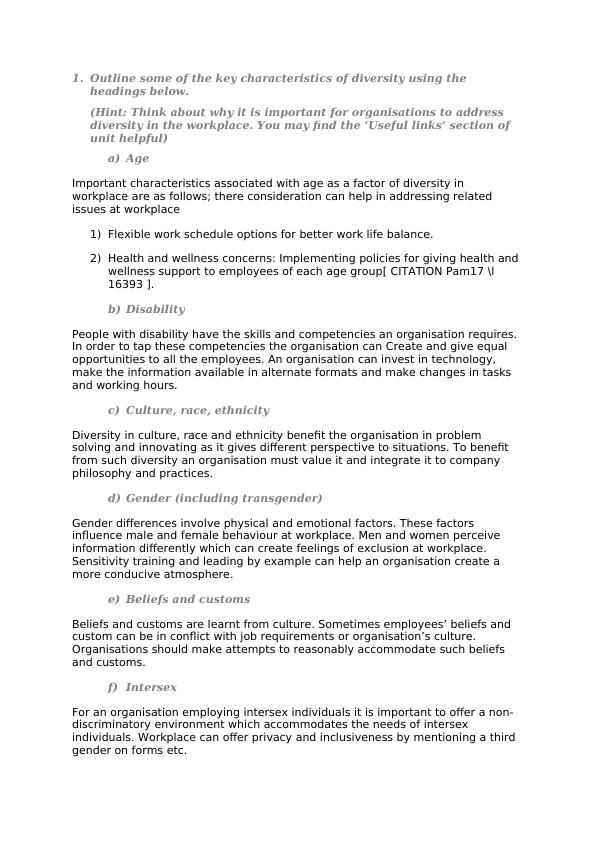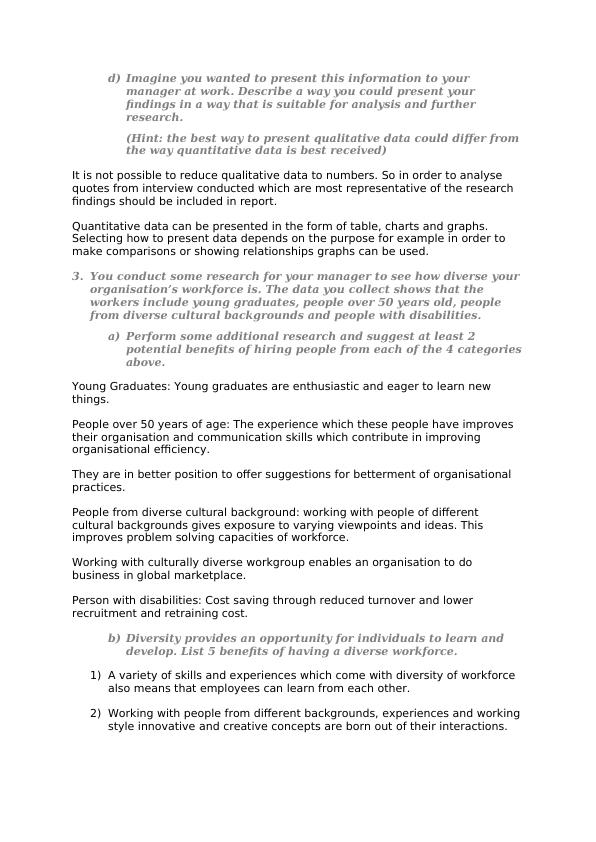The Impact of Workplace Diversity on Organisations
Added on 2020-05-16
16 Pages5159 Words245 Views
Assessment Task One: Short Answer Questions1.Define the following terms. In your answer, you should provide an example of a way each one impacts your role in the community services sector. a)DiversityDiversity describes the similarity and differences people have. These differences and similarities can be in perspectives, identities and point of views among the members of an institution (educational institutes, workplace etc.) as well as in the individuals who make up the wider community. The term diversity encompasses dimensions like race, ethnicity, gender, socio-economic status, nationality, citizenship, religion, sexual orientation, ability and age. For example,while working as a volunteer at old age home knowledge and sensitivity about diversity has helped in better understanding the specific needs and concerns of its residents.b)Cultural awarenessCultural awareness is essential while communicating with people of different cultures. Cultural awareness is about understanding that the meaning people give to certain activities could be different from your own for example, table manners or dress code[ CITATION Ele14 \l 16393 ]. For example, while working ata community service centre cultural awareness can help in reduce misunderstandings caused due to different perceptions. c)Social awarenessSocial awareness can be defined as being aware of problems societies and communities face on day to day basis. Social awareness also means that there isunderstanding about different social situations and modifying the responses accordingly to achieve best results. Being socially aware while serving at a community service centre helps in understanding and empathizing with someonehence, facilitating in providing better care or service. d)Cultural safetyThe term cultural safety means creating an environment where the identity of anindividual is not assaulted or challenged[ CITATION Wil08 \l 16393 ]. For examplein nursing profession to protect the cultural safety of patient and to create trusting relationship, the behaviour and attitude of nurse towards the patient willplay an important role. e)Cultural competenceCultural competence is the ability to understand and effectively respond to a combination of cultural variables and the full range of dimensions of diversity. For example while interacting with a patient at health centre or with his/her family cultural competence helps in listening without judgement and extending help in whichever way possible.

1.Outline some of the key characteristics of diversity using the headings below. (Hint: Think about why it is important for organisations to address diversity in the workplace. You may find the ‘Useful links’ section of unit helpful)a)Age Important characteristics associated with age as a factor of diversity in workplace are as follows; there consideration can help in addressing related issues at workplace1)Flexible work schedule options for better work life balance.2)Health and wellness concerns: Implementing policies for giving health and wellness support to employees of each age group[ CITATION Pam17 \l 16393 ]. b)DisabilityPeople with disability have the skills and competencies an organisation requires. In order to tap these competencies the organisation can Create and give equal opportunities to all the employees. An organisation can invest in technology, make the information available in alternate formats and make changes in tasks and working hours.c)Culture, race, ethnicityDiversity in culture, race and ethnicity benefit the organisation in problem solving and innovating as it gives different perspective to situations. To benefit from such diversity an organisation must value it and integrate it to company philosophy and practices.d)Gender (including transgender)Gender differences involve physical and emotional factors. These factors influence male and female behaviour at workplace. Men and women perceive information differently which can create feelings of exclusion at workplace. Sensitivity training and leading by example can help an organisation create a more conducive atmosphere.e)Beliefs and customsBeliefs and customs are learnt from culture. Sometimes employees’ beliefs and custom can be in conflict with job requirements or organisation’s culture. Organisations should make attempts to reasonably accommodate such beliefs and customs. f)IntersexFor an organisation employing intersex individuals it is important to offer a non-discriminatory environment which accommodates the needs of intersex individuals. Workplace can offer privacy and inclusiveness by mentioning a third gender on forms etc.

g)Sexuality/identity (such as lesbian, gay, bisexual, heterosexual etc.)LGBT supportive policies or environment is linked to the openness about being LGBT. Climate of non-discrimination at workplace has improved health outcomes,increased job satisfaction and greater job commitment[ CITATION MVL13 \l 16393 ]. h)LanguageLanguage difference at workplace can hinder effective communication at workplace. Workers who are not comfortable using the primary language might face difficulty in expressing their needs and responding to their colleagues. If thejob involves customer interaction worker may have difficulty in understanding customers’ requirement. To put people who speak diverse languages at ease in aworkplace practices like: basic training of primary language, using combination of verbal and non-verbal communication can be used. 2.Evaluating quantitative and qualitative data can be an extremely useful tool in the workplace. a)Describe the key differences between these two types of informationQualitative data is concerned with descriptions which can be observed but not computed. On the other hand quantitative data focuses on data which can be represented in numbers and can be computed. Qualitative data provides understanding about a problem and the nature of data is descriptive. Quantitative data comprises of values on which calculations can be done to reach a decision.b)For each type, suggest 2 examples that relate to the diversity within a workplace.Quantitative data to measure workplace diversity in terms of workplace factors which can be numerated for example:- employers can evaluate gender based promotions, number of employees who are able to access programs and servicesoffered by organisation, demographics of new hires etc.Qualitative data to measure workforce diversity: Employers record data about behaviour, work habits and types of obstacles that workers must overcome to perform their jobs effectively.c)Explain 2 ways that you can collect this informationQualitative data about types of obstacles workers are facing can be collected by the way of interviews.Data about demographics of new and existing employees can be recorded in questionaries and forms.

d)Imagine you wanted to present this information to your manager at work. Describe a way you could present your findings in a way that is suitable for analysis and further research.(Hint: the best way to present qualitative data could differ fromthe way quantitative data is best received)It is not possible to reduce qualitative data to numbers. So in order to analyse quotes from interview conducted which are most representative of the research findings should be included in report. Quantitative data can be presented in the form of table, charts and graphs. Selecting how to present data depends on the purpose for example in order to make comparisons or showing relationships graphs can be used. 3.You conduct some research for your manager to see how diverse yourorganisation’s workforce is. The data you collect shows that the workers include young graduates, people over 50 years old, people from diverse cultural backgrounds and people with disabilities. a)Perform some additional research and suggest at least 2 potential benefits of hiring people from each of the 4 categoriesabove.Young Graduates: Young graduates are enthusiastic and eager to learn new things.People over 50 years of age: The experience which these people have improves their organisation and communication skills which contribute in improving organisational efficiency.They are in better position to offer suggestions for betterment of organisational practices.People from diverse cultural background: working with people of different cultural backgrounds gives exposure to varying viewpoints and ideas. This improves problem solving capacities of workforce.Working with culturally diverse workgroup enables an organisation to do business in global marketplace.Person with disabilities: Cost saving through reduced turnover and lower recruitment and retraining cost.b)Diversity provides an opportunity for individuals to learn and develop. List 5 benefits of having a diverse workforce. 1)A variety of skills and experiences which come with diversity of workforce also means that employees can learn from each other.2)Working with people from different backgrounds, experiences and workingstyle innovative and creative concepts are born out of their interactions.

End of preview
Want to access all the pages? Upload your documents or become a member.
Related Documents
Work and Diversity: Understanding Personal Cultural Competence and the Importance of Diversity in the Workplacelg...
|10
|2165
|127
Understanding Diversity in Healthcarelg...
|16
|3777
|92
Cultural Awareness and Impact on Workplace Roleslg...
|8
|2691
|46
Nursing Project with Cultural Diversitylg...
|17
|3500
|76
Work With Divorce People Question and Answer 2022lg...
|10
|1912
|22
Working with Diverse and Aboriginal Australianslg...
|10
|1908
|482
